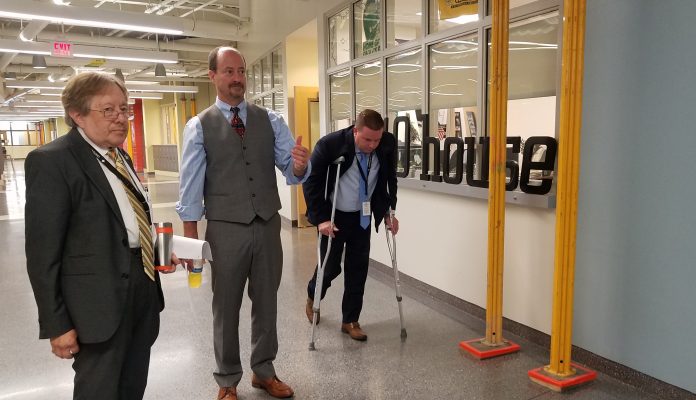In March, Centennial School District administration noticed some spalling, or cracking, in the hallway walls and ceiling of William Tennent High School, located at 333 Centennial Road in Warminster.
According to Robert Whartenby, the district’s director of facilities, the issue was thought to be strictly cosmetic. As it turns out, the spalling was merely a symptom of a more serious diagnosis.
On Friday, Aug. 16, after receiving shop drawings from the school’s original contractor and further investigation, structural defects were discovered in the Academic Wing of William Tennent, which was constructed in 2010. While engineers evaluated the condition of the property and developed a solution, superintendent Dr. David Baugh called for limited access to the building.
During a news conference on Tuesday, Aug. 27, Baugh, along with Whartenby and school board member Mark Miller, detailed the temporary solution that was recently implemented.
According to Baugh, Wiliam Tennent is once again safe, and ready to welcome 1,700 students for the first day of classes on Tuesday, Sept. 3.
“It was a bit of a surprise to encounter these structural deficiencies,” he said. “We are extremely pleased to have found them before some kind of catastrophe occurred.”
By Monday, Aug. 19, the district was in touch with Todd Gerhart, a senior forensic engineer with Barry Isett & Associates, who quickly devised a plan to temporarily fix the problem, all while ensuring student safety.
Throughout the hallways, 130 yellow poles were installed from floor to ceiling in a shoring process, completed by Eastern Scaffolding and Shoring Inc. Each pole is capable of holding 20,000 pounds, and is able to support the building’s steel framing if it fails.

The total installation cost was $35,000, with a $22,000 per month rental fee for the shoring.
Baugh, Whartenby and Miller were in agreement that they’re glad the spalling happened. Ultimately, this minor issue helped them know a major problem was occuring behind the scenes, and to take action before it was too late.
“Unfortunately, we wouldn’t have known until something catastrophic would’ve happened. And then we wouldn’t be having this conversation. It would’ve been very different and sad,” said Whartenby.
“The fear was if this collapsed, kind of like a zipper,” Miller said, gesturing to the hallway ceiling.
While there is now a uniform distribution of support throughout the entire building, a permanent solution is in the works. Gerhart is in the process of developing a cost-effective design over the next several weeks. Until this is done, Whartenby said the time frame of the permanent project is still to be determined – it will either be completed in small phases during the academic year, or all at once in summer 2020.
“Now that it’s not an emergency, we’re in really good shape and we have a chance to catch our breath,” Baugh said. ••
Samantha Bambino can be reached at [email protected]


